64 Cores of Rendering Madness: The AMD Threadripper Pro 3995WX Review
by Dr. Ian Cutress on February 9, 2021 9:00 AM EST- Posted in
- CPUs
- AMD
- Lenovo
- ThinkStation
- Threadripper Pro
- WRX80
- 3995WX
CPU Tests: Encoding
One of the interesting elements on modern processors is encoding performance. This covers two main areas: encryption/decryption for secure data transfer, and video transcoding from one video format to another.
In the encrypt/decrypt scenario, how data is transferred and by what mechanism is pertinent to on-the-fly encryption of sensitive data - a process by which more modern devices are leaning to for software security.
Video transcoding as a tool to adjust the quality, file size and resolution of a video file has boomed in recent years, such as providing the optimum video for devices before consumption, or for game streamers who are wanting to upload the output from their video camera in real-time. As we move into live 3D video, this task will only get more strenuous, and it turns out that the performance of certain algorithms is a function of the input/output of the content.
HandBrake 1.32: Link
Video transcoding (both encode and decode) is a hot topic in performance metrics as more and more content is being created. First consideration is the standard in which the video is encoded, which can be lossless or lossy, trade performance for file-size, trade quality for file-size, or all of the above can increase encoding rates to help accelerate decoding rates. Alongside Google's favorite codecs, VP9 and AV1, there are others that are prominent: H264, the older codec, is practically everywhere and is designed to be optimized for 1080p video, and HEVC (or H.265) that is aimed to provide the same quality as H264 but at a lower file-size (or better quality for the same size). HEVC is important as 4K is streamed over the air, meaning less bits need to be transferred for the same quality content. There are other codecs coming to market designed for specific use cases all the time.
Handbrake is a favored tool for transcoding, with the later versions using copious amounts of newer APIs to take advantage of co-processors, like GPUs. It is available on Windows via an interface or can be accessed through the command-line, with the latter making our testing easier, with a redirection operator for the console output.
We take the compiled version of this 16-minute YouTube video about Russian CPUs at 1080p30 h264 and convert into three different files: (1) 480p30 ‘Discord’, (2) 720p30 ‘YouTube’, and (3) 4K60 HEVC.
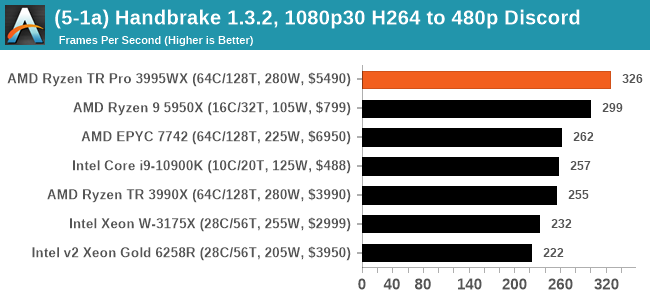
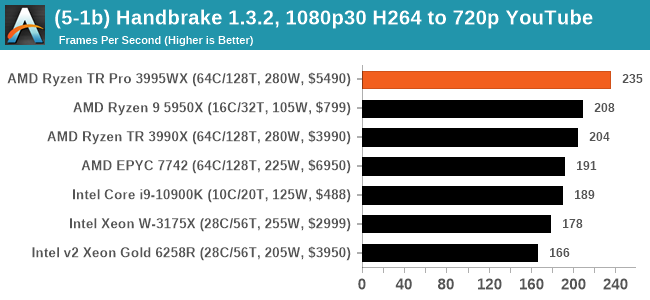
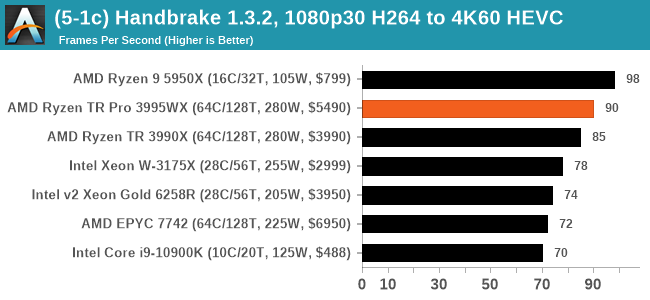
For the lower resolution modes, it would appear that the increased memory bandwidth plays a role for the 3995WX and 7742, although single core frequency also means a lot. Moving to the HEVC metrics, the Ryzen 9 takes a win here, but the 3995WX still goes above the 3990X.
7-Zip 1900: Link
The first compression benchmark tool we use is the open-source 7-zip, which typically offers good scaling across multiple cores. 7-zip is the compression tool most cited by readers as one they would rather see benchmarks on, and the program includes a built-in benchmark tool for both compression and decompression.
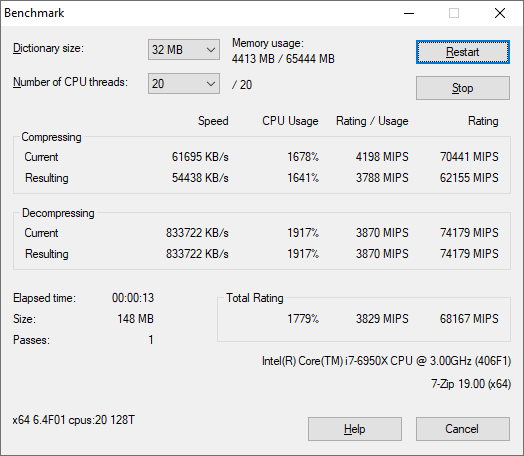
Example Test Run on an Intel 10-core i7-6950X
The tool can either be run from inside the software or through the command line. We take the latter route as it is easier to automate, obtain results, and put through our process. The command line flags available offer an option for repeated runs, and the output provides the average automatically through the console. We direct this output into a text file and regex the required values for compression, decompression, and a combined score.
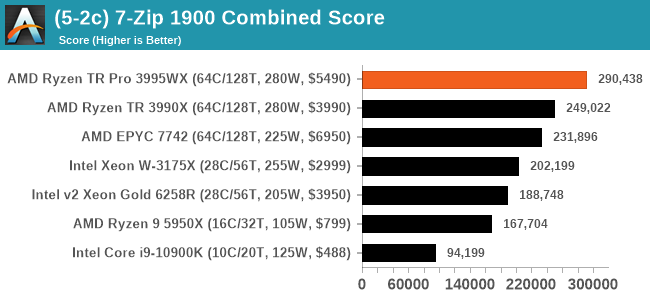
This is a 16.6% win for the TR Pro 3995WX.
AES Encoding
Algorithms using AES coding have spread far and wide as a ubiquitous tool for encryption. Again, this is another CPU limited test, and modern CPUs have special AES pathways to accelerate their performance. We often see scaling in both frequency and cores with this benchmark. We use the latest version of TrueCrypt and run its benchmark mode over 1GB of in-DRAM data. Results shown are the GB/s average of encryption and decryption.
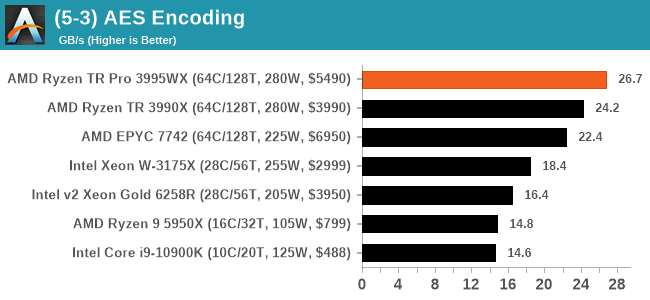
WinRAR 5.90: Link
For the 2020 test suite, we move to the latest version of WinRAR in our compression test. WinRAR in some quarters is more user friendly that 7-Zip, hence its inclusion. Rather than use a benchmark mode as we did with 7-Zip, here we take a set of files representative of a generic stack
- 33 video files , each 30 seconds, in 1.37 GB,
- 2834 smaller website files in 370 folders in 150 MB,
- 100 Beat Saber music tracks and input files, for 451 MB
This is a mixture of compressible and incompressible formats. The results shown are the time taken to encode the file. Due to DRAM caching, we run the test for 20 minutes times and take the average of the last five runs when the benchmark is in a steady state.
For automation, we use AHK’s internal timing tools from initiating the workload until the window closes signifying the end. This means the results are contained within AHK, with an average of the last 5 results being easy enough to calculate.
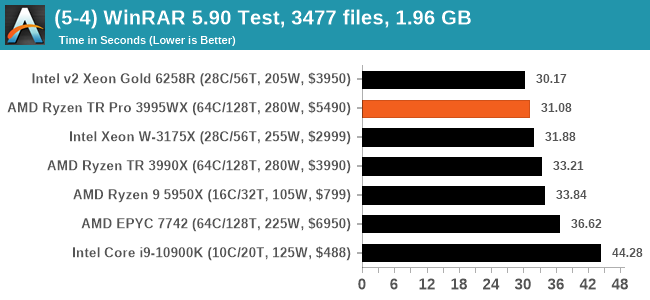
WinRAR is variable threaded, but the Xeon Gold takes the win here - even compared to the Xeon W-3175X. It's all relatively close at the top end.


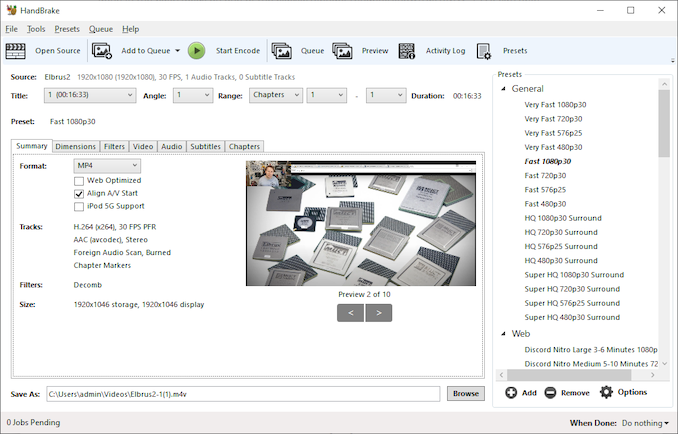
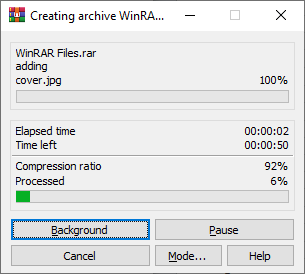








118 Comments
View All Comments
Fellovv - Tuesday, February 9, 2021 - link
Agreed— picked up a p620 with 16c for $2500, could have gotten it for lower from Lenovo if they didn’t have weeks of lead time. Ian- you may see Lenovo discounts all the crazy prices about 50% all year, and sometimes there are Honey coupons to knock off hundreds more.I have read that the 16c 2 CCX 3955WX May only get 4 channel RAM, not the full 8. I may be able to confirm in the near future. Gracias for the fine and thorough review. My only request is to ensure the TR 3990 is included in every graph— it was MIA or AWOL in several. I went with they TR Pro for the RAM and PCIe 4 lanes. Seeing the results confirms it was a good choice for me. Can’t wait for the Zen3!
realbabilu - Tuesday, February 9, 2021 - link
Nice 👍 about mkl, how about blis and open las,.did it suffer high multi core problemMonkeyMan73 - Wednesday, February 10, 2021 - link
AMD has the performance crown in most scenarios, but it comes at an extremely high price point. Might not be worth this kind of money even for most extreme power user. Maybe get a dual core Xeon? Might be cheaper.BTW, your las pic of this review is definitly not an OPPO Reno 2 :)
MonkeyMan73 - Wednesday, February 10, 2021 - link
Apologies, not a Dual core Xeon, that will not cut it but meant a Dual Socket Xeon setup.Oxford Guy - Wednesday, February 10, 2021 - link
The worst aspect of the price-to-performance is that it’s using outdated tech rather than Zen 3.MonkeyMan73 - Sunday, February 28, 2021 - link
Correct, there is always some sort of trade-off.Greg13 - Wednesday, February 10, 2021 - link
I feel like you guys really need to get some more memory intensive workloads to test. So often in these Threadripper / Threadripper Pro / EPYC reviews, the consumer CPU (5950X in this case) is often faster or not far behind even on highly multithreaded applications. I do some pretty large thermal fluid system simulations in Simscape where by once a system is designed I use an optimisation algorithm to find the optimal operating parameters of the system. This involves running multiple simulations of the same model in parallel using Matlab Parallel computing toolbox along with their global optimisation toolbox. Last year I bought a 3950X and 128GB ram to do this, but as far as I can tell it is massivly memory bandwidth limited. It's also memory capacity limited too... Each simulation uses around 10GB ram each, so I generally only run 12 parallel workers to keep within the 128GB of ram. However, In terms of throughput I see barely any change when dropping down to 8 parallel workers, suggesting, I think that with 12 workers, it's massivly memory bandwidth limited. This also seems to be the case in terms of the CPU power, even with 12 workers going, the CPU power reported is pretty low, which leads me to think it's waiting for data from memory?I assume that this would be better with Threadripper or even better with Threadripper Pro with their double and quadrouple memory bandwidth. However I don't have the funds to buy a selection of kit and test it to see if the extra cost is worth it. It would be good if you guys could add some more memory intensive tests to the suite (ideally for me some parallel Simscape simulations!) to show the benefit these extra memory channels (and capacity) offer.
Shmee - Wednesday, February 10, 2021 - link
Yeah I would wait for Zen 3 TR for sure. That said, this would only make sense as X570 has limited IO. It would be great to have a nice 16 core TR that had great OC capability and ST performance, was great in games, and did not have the IO limitation as X570. I really don't need all the cores, mainly I care about gaming, but the current gaming platforms just don't have the SATA and m.2 ports I would like. Extra memory bandwidth is also nice.eastcoast_pete - Wednesday, February 10, 2021 - link
Thanks Ian! I really wanted one, until I saw the system price (: But, for what these proTRs can do, a price many are willing and able to pay.Also, as it almost always comes up in discussions of AMD vs Intel workstation processors: could you write a backgrounder on what AVX is/is used for, and how open or open source extensions like AVX512 really are? My understanding is that much of this is proprietary to Intel, but are those AVX512 extensions available to AMD, or do they have to engineer around it?
kgardas - Wednesday, February 10, 2021 - link
avx512 is instruction set implemented and invented by Intel. Currently available in TigerLake laptops and Xeon W desktops plus of course server Xeons. Previous generation was AVX2 and generation before AVX. AVX comes with Intel's SandyBridge cores 9 years ago IIRC. AVX2 with Haswell.Due to various reasons IIRC AMD and Intel cross-licensed their instruction sets years ago. Intel needed AMD's AMD64 to compete. Not sure if the part of the deal is also future extensions, but I would guess so since AMD since that time implemented both AVX and AVX2. Currently AMD sees no big pressure from Intel hence I guess is not enough motivated to implement avx512. Once it is, I guess we will see AMD chips with avx512 too.